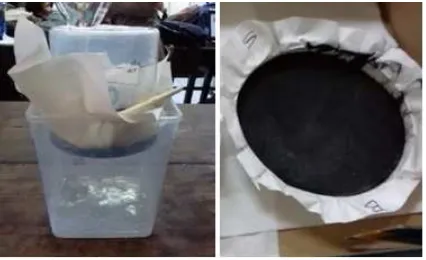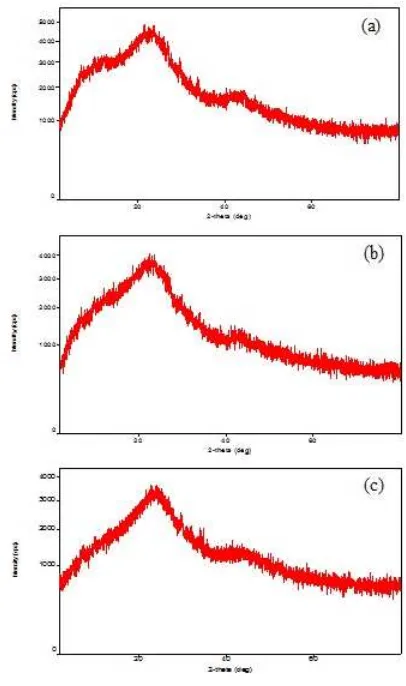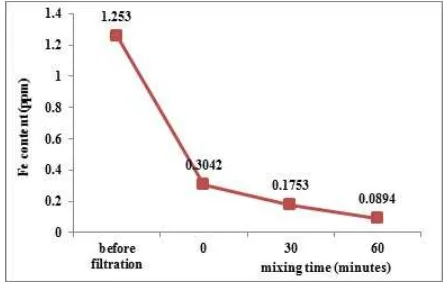Omega: Jurnal Fisika dan Pendidikan Fisika3(2), 50 - 54 (2017)
(Journal of Physics and Physics Education)
Preparation and Synthesis of Micro-Sized Carbon Material from Coconut
Shell with Variation of Material Mixing Time Using a Blender for Fe
Filtration of Mataram Canal Water
Irnawati Widya Hastuti, Nur Baeity Andriani, Buky Wahyu Pratama, Wipsar Sunu
Brams Dwandaru*
Colloids and Soft Matter Group, Physics Education Department Faculty of Mathematics and Natural Sciences, Universitas Negeri Yogyakarta
Karangmalang Complex, Yogyakarta 55281, Indonesia
(Received 12 June 2017; published 29 November 2017)
Abstract
This study aims to synthesis micro-sized carbon material from coconut shell leftovers or wastes using piezoelectric-based ultrasonication in liquid phase. The micro-sized carbon material produced is then utilized as a filtration material for Mataram canal water in Yogyakarta. This study begins with synthesizing the micro-sized carbon material by mixing i) mashed coconut shells, ii) 100 ml distilled water, and iii) 2 grams of detergent into a blender. The aforementioned materials are blended with mixing time variation of 30 minutes and 60 minutes. The resulted solution is left alone for a night and then ultrasonicated for 4 hours. The solution is then characterized using UV-Vis spectrophotometer. The sediments obtained from the carbon materials are characterized using X-ray diffraction (XRD) for each mixing time variation whereas scanning electron microscopy (SEM) is conducted upon the micro-sized carbon material with 60 minutes mixing time. The solution and the sediment is poured onto a filter paper, heated until dry, and fitted to a simple filtration device. Water from Mataram canal is used to test the Fe filtration ability of the micro-sized carbon material. The water samples before and after filtration are characterized using atomic absorption spectroscopy (AAS). The UV-Vis results show that increasing the mixing time of material, increases the absorbance value. Based on XRD results the synthesized micro-sized carbon ma-terial from coconut shell has an amorphous phase. The SEM result at 60 minutes of mixing time looks like an irregular bulk material with sizes of about 1µm to 12µm with thicknesses of around 0.6 µm to 0.8 µm. The
AAS results indicate that the longer the mixing time, the lower the Fe content in the water samples after filtration.
c
2017 The Authors. Published by Pendidikan Fisika UHAMKA
Keywords: micro-sized carbon material, liquid sonication exfoliation, Mataram canal water, material mixing time, coconut shell
∗Corresponding author. E-mail address: [email protected]
Introduction
Water (H2O) is an important chemical
com-pound for the survival of all living beings [1, 2]. Especially for human, clean water is a basic require-ment that must exist for everyday needs and ac-tivities. Almost all human activities require clean
flavors. To get clean water we can utilize raw wa-ter sources such as rain wawa-ter [7], surface wawa-ter [8], and sea water [9], which is then processed into clean water [10,11,12] that is suitable to use.
The Mataram canal is a waterway that connects Progo and Opak rivers on the West and East of Yogyakarta, respectively. Mataram canal has enor-mous benefits and historical values for the people of Yogyakarta and surrounding areas through which the water flows. Over time the quality of Mataram canal water has decrease. The water is currently opaque and does not meet clean water standards so that the water cannot be utilized properly for the surrounding community. One way in overcom-ing this problem is to treat the water to a certain degree such that it may be clean, clear, and usable again. A simple method to treat dirty water into clean water is using macro-size filtration materials, such as gravel, sand, and charcoal. Moreover, the development of nanotechnology in the last decade contributes to the water treatments, such as mi-crofiltration [13], ultrafiltration [14], nanofiltration [15], and reserve osmosis [12]. In this study, we ex-plore filtration material by treating coconut shell leftovers or wastes into micro-size carbon materials incorporated into a simple filtration apparatus. Co-conut shell is known for lowering Fe metals in wells and rivers [16].
The micro-sized carbon material from coconut shell is synthesized by liquid sonication exfolia-tion (LSE) method assisted by surfactant con-tained in commercial detergent. Two main tools are used in the synthesis of the micro-sized car-bon material, that is a blender and a self-custom made piezoelectric-based ultrasonication appara-tus. The mixing time of the initial materials using the blender is varied for 30 minutes and 60 minutes, and with constant ultrasonication of 4 hours. Fur-thermore, the solution obtained from the LSE treat-ment is characterized using UV-Vis spectroscopy and the sediment obtained is characterized using XRD. SEM is conducted for the sediment with 60 minutes of mixing time. Finally, the AAS is used to determine the Fe content in the samples of Mataram canal water before and after filtration using the micro-sized carbon material from coconut shell left-overs or wastes.
Experimental Methods
This study is conducted from the month of September 2016 through February 2017. The study is done in Colloids and Soft Matter Labo-ratory, Physics Education Department, Universitas Negeri Yogyakarta. The UV-Vis spectroscopy and
Research Laboratory, Universitas Gadjah Mada. Finally, AAS characterization is done in Atomic Physics Laboratory, Physics Education Depart-ment, Universitas Negeri Yogyakarta.
This study is initiated with synthesizing the micro-sized carbon material from coconut shell wastes. The basic materials needed are mashed co-conut shell, 100 ml of distilled water, and 2 grams of detergent. These materials are poured into a blender and then mixed with varying mixing time of 30 minutes and 60 minutes. The solution obtained is then left to equilibrate for a night. Next, the so-lution is ultrasonicated for 4 hours. Two kinds of phases are obtained, that is liquid (on top) and sed-iment (on the bottom). The liquid is characterized using UV-Vis spectroscopy, whereas the sediments are characterized using XRD. SEM is conducted for the sediment with 60 minutes mixing time using the blender. The material (liquid and sediment) ob-tained after the above liquid exfoliation method is then poured onto a filter paper, which is then in-corporated into a simple filtration apparatus (left picture of Figure 1). The filter paper containing the micro-sized carbon material is heated until dry (right picture of Figure1), and ready to be used for water filtration.
Water samples from Mataram canal is inserted into the filtration apparatus which is filtered and then gathered on a plastic container. The water be-fore and after filtration is characterized using AAS in order to determine their Fe content.
Figure 1: The simple filtration apparatus (left) and the micro-sized carbon material from coconut shell leftovers (right).
Results and Discussion
mum absorbance or an absorbance peak is obtained only for 60 minutes (1 hour) of blending time shown by the (blue) dashed-line in Figure2 at about 235 nm. This peak indicates the existence of graphene oxide (GO) material from the carbon source of co-conut shell. However, no peak is observed for 30 minutes of blending time which is shown by the (red) solid-line of Figure 2. This means that half an hour of blending time is not enough to produce micro-sized or GO materials.
Figure 2: Graph of UV-Vis spectroscopy results with variation of mixing time of the materials.
XRD characterization is performed to determine the crystalline phase of the sediment obtained. The characterization is conducted using Cu source with wavelength of 1.54060 ˚A and the 2θ that ranges from 2◦ to 80◦. Figure3 shows the XRD patterns
of the coconut shell carbon materials without blend-ing (a) and with variation of mixblend-ing time [(b) and (c)]. Overall, the three graphs in Figure 3 show XRD patterns which are similar. This is because the material comes from the same source of coconut shell. Moreover, no sharp peaks may be observed
from all of the XRD patterns which indicate that the materials are amorphous. It can also be seen that increasing the mixing time decreases the XRD intensity.
Figure 3: XRD pattern with blender time variation (a) without blender (b) 30 minutes (c) 60 minutes.
SEM is performed to determine the surface mor-phology, shape, and also size of the micro-sized car-bon material, especially with 60 minutes blending time. The characterized sample is magnified with 1000 times and 3000 times magnifications. Figure 4(a) is the SEM result with 1000× magnification showing the distribution of the micro-sized carbon materials with various sizes and shapes. In Figure 4(b) i.e. 3000×magnification, more obvious chunks of coconut shell carbon can be observed with grain sizes of approximately 1.27µm to 12.5µm and gran-ular thicknesses of about 0.576µm to 0.829µm.
In this study, the water which is intended for filtration comes from Mataram canal with volume of 250 ml. Mataram canal water is being filtrated via a simple filtration device which consists of conut shell carbon material without blending, co-conut shell carbon material with 30 minutes blend-ing time, and micro-sized coconut carbon material with 60 minutes of blending time. Characterization of the Mataram canal water concerning the Fe con-tent before and after the aforementioned filtration treatments is conducted through the AAS test. The results are given in Figure5.
Figure 5: AAS results of the Fe content for Mataram canal water samples before and after filtration treat-ments.
Figure5shows the Fe content in Mataram canal water sample before filtration as much as 1.253 ppm meaning that in every 1 liter of the Mataram canal water sample there is about 1.253 mg Fe in it. After filtration using a simple filtration tool made from coconut shell carbon material and reinforced with a filter paper it can be seen that the Fe content decreases considerably. The Fe contents using co-conut shell carbon material without blending, with 30 minutes blending, and with 60 minutes blending become 0.3042 ppm, 0.1753 ppm, and 0.0894 ppm, respectively. Hence, the longer the mixing time of the materials, the smaller the Fe content produced via filtration.
the surface area of the carbon materials becomes larger such that more Fe metal ions are absorbed by the carbon materials. Moreover, water impuri-ties can also be trapped in the pores of the carbon materials. This is due to the iron (Fe2+) ion which
is lacking in two electrons causing the ion to be pos-itively charged and allowing it to be trapped in the pores of the coconut shell carbon materials. Then there may be a cation exchange between Fe ions with ions located on the surface of the carbon ma-terial pores causing bonding between the surface of the carbon pores and the Fe metal ions.
Conclusion
Micro-sized carbon material from coconut shell leftovers or wastes has been produced via the LSE method and used as a filtration material for Mataram canal water. UV-Vis spectrophotometer characterization shows a peak at 235 nm for 60 min-utes of blending time and increase of absorbance values as the mixing time is increased from 30 min-utes to 60 minmin-utes. XRD results show that the sediments of the micro-sized carbon materials are amorphous with decreasing diffraction intensities as the blending time is increased. SEM results for 60 minutes of blending time show irregular chunks of carbon material of various shapes and sizes of about 1.274 µm to 12.502 µm and thicknesses of about 0.576 µm to 0.829µm. Finally, AAS results indi-cate that increasing the mixing time of the materials resulted in the decrease of the Fe content of the wa-ter sample from 1.253 ppm before filtration to 0,089 ppm after filtration with 60 minutes blending time.
References
[1] D. Gomes, A. Agasse, P. Thi´ebaud, S. Delrot, H. Ger´os, and F. Chaumont, Aquaporins are mul-tifunctional water and solute transporters highly divergent in living organisms, Biochim. Biophys. Acta, Biomembr.1788(6), 1213-1228 (2009).
[2] L. C. Lim, P. Dhert, and P. Sorgeloos, Recent de-velopments in the application of live feeds in the freshwater ornamental fish culture,Aquacult.227
(1-4), 319-331 (2003).
[3] C. Alexander, M. S. Akhtar, P. Das, and S. C. Mandal, Nutri-biotechnological interventions for maximization of growth in carps of India, World Aquacult.42(2), 6 (2011).
[5] S. H. Lin and R. S. Juang, Adsorption of phe-nol and its derivatives from water using synthetic resins and low-cost natural adsorbents: a review,
J. Environ. Manage.90(3), 1336-1349 (2009).
[6] PERMENKES RI No.492/MENKES/PER/IV/ 2010.
[7] C. E. Junge and R. T. Werby, The concentration of chloride, sodium, potassium, calcium, and sulfate, J. Meteorolog.15, 417-425 (1958).
[8] X. Liang, D. P. Lettenmaier, E. F. Wood, and S. J. Burges, A simple hydrologically based model of land surface water and energy fluxes for general cir-culation models,J. Geophys. Res.99(D7),
14415-14428 (1994).
[9] L. Y. Hui, Diffusion of ions in sea water and in deep-sea sediments, Geochim. Cosmochim. Acta
38(5), 703-714 (1974).
[10] M. Wu and M. Gharib, Experimental studies on the shape and path of small air bubbles rising in clean water,Phys. Fluids14, L49 (2002).
[11] M. A. Shannon, P. W. Bohn, M. Elimelech, J. G. Georgiadis, B. J. Mari˜nas, and A. M. Mayes, Sci-ence and technology for water purification in the coming decades,Nature452, 301-310 (2008).
[12] T. -S. Chung, X. Li, R. C. Ong, Q. Ge, H. Wang, and G. Han, Emerging forward osmosis (FO)
tech-nologies and challenges ahead for clean water and clean energy applications,Curr. Opin. Chem. Eng.
1(3), 246-257 (2012).
[13] C. C. Ho and A. L. Zydney, A combined pore block-age and cake filtration model for protein fouling during microfiltration,J. Colloid Interface Sci.232
(2), 389-399 (2000).
[14] M. R. Costanzo, M. E. Guglin, M. T. Saltzberg, M. L. Jessup, B. A. Bart, J. R. Teerlink, B. E. Jaski, J. C. Fang, E. D. Feller, G. J. Haas, A. S. Anderson, M. P. Schollmeyer, P. A. Sobotka, and UNLOAD Trial Investigators, Ultrafiltration ver-sus intravenous diuretics for patients hospitalized for acute decompensated heart failure,J. Am. Coll. Cardiol.49(6), 675-683 (2007).
[15] S. Hong and M. Elimelech, Chemical and physical aspects of natural organic matter (NOM) fouling of nanofiltration membranes, J. Membr. Sci.132
(2), 159-181 (1997).
[16] A. bin Jusoh, W. H. Cheng, W. M. Low, A. Nora’aini, and M. J. M. M. Noor, Study on the removal of iron and manganese in groundwater by granular activated carbon,Desalin.182(1-3),


